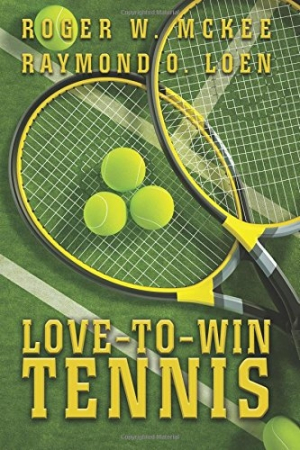Love-To-Win Tennis
Win More and Lose Less
Easy-to-follow tennis tips help players at all levels get into the swing of things.
Roger W. McKee knows tennis. Raymond O. Loen knows organizational training. Together, they’ve intermingled three decades worth of experience in their respective fields to create Love-To-Win Tennis, a training manual for tennis players of all levels.
Loen’s corporate training background is apparent in the approach of the book, which features one-syllable focus words for specific tennis techniques (“SNAP” for a flat serve, “AIM” for ball placement, etc.) and one-sentence strategies for winning specific matches.
The duo approaches their training tips meticulously, covering seventy-three different skills. Each skill has a dedicated page that includes its focus word, proper grip, three “action steps,” and three photos that illustrate each action step. McKee, a thirty-year teaching and playing professional, is the creator of the tips and the subject in the images.
McKee’s contributions include not only the extensive physical tips, but also suggestions on how to approach the game mentally. His 80/20 strategy suggests players do less reacting to an opponent’s play and instead be more proactive by developing their own game plan, taking advantage of strengths, and avoiding weaknesses. “Here you attempt to get 80 percent of your results through 20 percent of your skills,” he writes.
While painstakingly thorough, the book at times gives the impression of being more complicated than it needs to be. There’s an imposing early section titled “How to Use This Book” that outlines how ten common faults and fixes correlate to the skills that will be addressed in each section, which are then boiled down to focus words and strategies. The multiple layers can become cumbersome.
However, when looking for help with a specific issue, the tips are well described and easy to follow (although the associated images can be too small to notice intricate grip changes or body positioning, a shortcoming of the medium). That’s how the authors intend beginning and intermediate players to use the book—as a reference to look up one or two faults and fix them, improving their game and simultaneously increasing enjoyment of the sport. Advanced players may opt to use it more as a step-by-step checklist for improving all aspects of their game.
Like the photos illustrating technique, the one-page performance rating forms included in the text are too small, making them difficult to read and fill out. The book might be better presented as an 8.5“ x 11“ workbook instead of the more typical 6“ x 9“ novel size.
Regardless of format, McKee’s tips are valuable training material that tennis players of all competitive levels should enjoy and benefit from. His choice of Loen as a doubles partner for this project no doubt improved his own game and the final product.
Reviewed by
Rich Rezler
Disclosure: This article is not an endorsement, but a review. The publisher of this book provided free copies of the book and paid a small fee to have their book reviewed by a professional reviewer. Foreword Reviews and Clarion Reviews make no guarantee that the publisher will receive a positive review. Foreword Magazine, Inc. is disclosing this in accordance with the Federal Trade Commission’s 16 CFR, Part 255.

